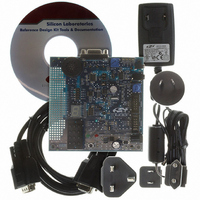DTMFDECODER-RD Silicon Laboratories Inc, DTMFDECODER-RD Datasheet - Page 126

DTMFDECODER-RD
Manufacturer Part Number
DTMFDECODER-RD
Description
KIT REF DESIGN DTMF DECODER
Manufacturer
Silicon Laboratories Inc
Specifications of DTMFDECODER-RD
Mfg Application Notes
DTMF Decoder Ref Design AppNote
Main Purpose
Telecom, DTMF Decoder
Embedded
No
Utilized Ic / Part
C8051F300
Primary Attributes
8kHz Sampling Rate ADC
Secondary Attributes
16 Goertzel Filters
Processor To Be Evaluated
C8051F300
Interface Type
RS-232
Lead Free Status / RoHS Status
Contains lead / RoHS non-compliant
Lead Free Status / RoHS Status
Lead free / RoHS Compliant, Contains lead / RoHS non-compliant
Other names
336-1283
- Current page: 126 of 178
- Download datasheet (2Mb)
C8051F300/1/2/3/4/5
13.5.4. Slave Transmitter Mode
Serial data is transmitted on SDA and the clock is received on SCL. When slave events are enabled (INH
= 0), the interface enters Slave Receiver Mode (to receive the slave address) when a START followed by a
slave address and direction bit (READ in this case) is received. Software responds to the received slave
address with an ACK, or ignores the received slave address with a NACK. If the received address is
ignored, slave interrupts will be inhibited until the next START is detected. If the received slave address is
acknowledged, software should write data to SMB0DAT to force the SMBus into Slave Transmitter Mode.
The switch from Slave Receiver to Slave Transmitter requires software management. Software should per-
form the steps outlined below only when a valid slave address is received (indicated by the label “RX-to-TX
Steps” in Figure 13.8).
The interface enters Slave Transmitter Mode and transmits one or more bytes of data (the above steps are
only required before the first byte of the transfer). After each byte is transmitted, the master sends an
acknowledge bit; if the acknowledge bit is an ACK, SMB0DAT should be written with the next data byte. If
the acknowledge bit is a NACK, SMB0DAT should not be written to before SI is cleared (Note: an error
condition may be generated if SMB0DAT is written following a received NACK while in Slave Transmitter
Mode). The interface exits Slave Transmitter Mode after receiving a STOP. Note that the interface will
switch to Slave Receiver Mode if SMB0DAT is not written following a Slave Transmitter interrupt.
Figure 13.8 shows a typical Slave Transmitter sequence. Two transmitted data bytes are shown, though
any number of bytes may be transmitted. Notice that the ‘data byte transferred’ interrupts occur after the
ACK cycle in this mode.
126
Step 1. Set ACK to ‘1’.
Step 2. Write outgoing data to SMB0DAT.
Step 3. Check SMB0DAT.7; if ‘1’, do not perform steps 4, 6 or 7.
Step 4. Set STO to ‘1’.
Step 5. Clear SI to ‘0’.
Step 6. Poll for TXMODE => ‘1’.
Step 7. Clear STO to ‘0’ (must be done before the next ACK cycle).
S
Received by SMBus
Interface
Transmitted by
SMBus Interface
SLA
Figure 13.8. Typical Slave Transmitter Sequence
Interrupt
Perform RX-to-TX
Steps Here
R
A
Data Byte
Rev. 2.9
Interrupt
A
S = START
P = STOP
N = NACK
W = WRITE
SLA = Slave Address
Data Byte
Interrupt
N
Interrupt
P
Related parts for DTMFDECODER-RD
Image
Part Number
Description
Manufacturer
Datasheet
Request
R
Part Number:
Description:
SMD/C°/SINGLE-ENDED OUTPUT SILICON OSCILLATOR
Manufacturer:
Silicon Laboratories Inc
Part Number:
Description:
Manufacturer:
Silicon Laboratories Inc
Datasheet:
Part Number:
Description:
N/A N/A/SI4010 AES KEYFOB DEMO WITH LCD RX
Manufacturer:
Silicon Laboratories Inc
Datasheet:
Part Number:
Description:
N/A N/A/SI4010 SIMPLIFIED KEY FOB DEMO WITH LED RX
Manufacturer:
Silicon Laboratories Inc
Datasheet:
Part Number:
Description:
N/A/-40 TO 85 OC/EZLINK MODULE; F930/4432 HIGH BAND (REV E/B1)
Manufacturer:
Silicon Laboratories Inc
Part Number:
Description:
EZLink Module; F930/4432 Low Band (rev e/B1)
Manufacturer:
Silicon Laboratories Inc
Part Number:
Description:
I°/4460 10 DBM RADIO TEST CARD 434 MHZ
Manufacturer:
Silicon Laboratories Inc
Part Number:
Description:
I°/4461 14 DBM RADIO TEST CARD 868 MHZ
Manufacturer:
Silicon Laboratories Inc
Part Number:
Description:
I°/4463 20 DBM RFSWITCH RADIO TEST CARD 460 MHZ
Manufacturer:
Silicon Laboratories Inc
Part Number:
Description:
I°/4463 20 DBM RADIO TEST CARD 868 MHZ
Manufacturer:
Silicon Laboratories Inc
Part Number:
Description:
I°/4463 27 DBM RADIO TEST CARD 868 MHZ
Manufacturer:
Silicon Laboratories Inc
Part Number:
Description:
I°/4463 SKYWORKS 30 DBM RADIO TEST CARD 915 MHZ
Manufacturer:
Silicon Laboratories Inc
Part Number:
Description:
N/A N/A/-40 TO 85 OC/4463 RFMD 30 DBM RADIO TEST CARD 915 MHZ
Manufacturer:
Silicon Laboratories Inc
Part Number:
Description:
I°/4463 20 DBM RADIO TEST CARD 169 MHZ
Manufacturer:
Silicon Laboratories Inc










